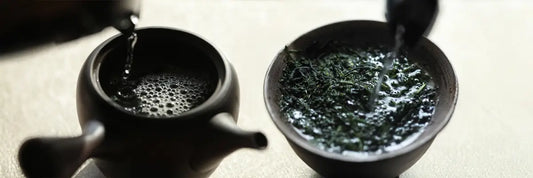Eating gyokuro leaves can be a great way to get the most out of your gyokuro, but there are a few things you’ll need to keep in mind before you try it.
In this article, we are going to share some things to avoid when eating gyokuro and some tips for eating gyokuro leaves.
By the time you finish reading this, you may have a new favorite dish! Let’s get started. 🥢🍃🍵
How to eat tea leaves: a complete step by step video guide
Guide to Eating Gyokuro Leaves
 When it comes to eating gyokuro leaves, there are a few things to keep in mind.
When it comes to eating gyokuro leaves, there are a few things to keep in mind.
1. Grown without pesticides
The first is that you want to go for a gyokuro grown without pesticides.
When you are consuming the entire tea leaf (like you might do with matcha tea as well) it is extremely important to go for a tea grown without pesticides or chemicals.
2. Consistency of the leaves

Another thing to keep in mind is the consistency of the leaves. When you are eating gyokuro leaves, you will notice they are really soft and smooth, almost like steamed spinach. These are probably the best consistency when it comes to eating, as they won’t cause any discomfort.
If you were to eat a rougher tea like hojicha, for example, it would be a lot more difficult. Hojicha is made from much coarser leaves and it contains stems as well. Hojicha is a fantastic tea to drink, but you want to be extra picky when it comes to eating gyokuro leaves.
In the next section, we will go through a few helpful tips when it comes to eating gyokuro. We’ll start by discussing the benefits of eating gyokuro, and then we’ll get into the different ways you can go about eating gyokuro so that it tastes good!
Benefits of Eating Gyokuro
There are a few benefits of eating gyokuro:
Minimizing the waste of the tea
The first is that you are minimizing the waste of the tea. When you brew tea leaves, it always seems like a shame to throw them in the garbage afterwards. They are still so full of flavor and nutrients. Some people like to put them in the blender. If you enjoy the gyokuro taste, you can also, of course, eat the leaves afterwards, and we’ll show you a few methods in the next section.
Get more nutrients from the tea
A second benefit of eating gyokuro is that you get more nutrients from the tea. If we compare gyokuro vs matcha, gyokuro leaves are not consumed but they are infused into water. This means that some compounds are extracted by the water, and some remain inside the leaf. If you want to get the most health benefits out of the tea leaves, you might want to start eating them! Just make sure they are pesticide-free.
Benefits of eating and drinking gyokuro go way beyond its delicious taste! There are 11 different benefits of drinking gyokuro tea. If you want to discover all of them, read our article 👉 Learn More about the Gyokuro Tea Benefits
Eating gyokuro leaves with rice
One way some people like to eat tea leaves is mixed over rice. It can be a bit hard to eat the tea leaves on their own, so you may want to try mixing them into a salad or a nice bowl of rice. You can then top it with a little bit of rice vinegar, soy sauce, etc., mix it up and enjoy.
There is a similar Japanese dish called Ochazuke, but this is not made with tea leaves but tea itself. Ocha means tea and zuke means “to submerge,” so the dish is simply made by pouring green tea on top of rice. If you really want to go for the tea theme on your next rice dish, you can try ochazuke and put the tea leaves on top of it. This might be a good flavor pairing!
Eating gyokuro leaves with sauce
If you’re thinking of eating gyokuro as more of a snack and less of a full meal, you can try mixing the leaves with a sauce. This is something they do at tea shops like Sakurai in Tokyo in order to not waste the precious gyokuro leaves. Here are a few options for eating gyokuro leaves:

Eating gyokuro leaves with soy sauce
Soy sauce makes a great complement to gyokuro leaves but make sure to use it sparingly. It provides a lot of flavor but also a lot of sodium, so be careful not to overdo it!
Eating gyokuro leaves with ponzu
Ponzu is another sauce that complements the flavor of gyokuro leaves. This is essentially a lemon vinaigrette that is used in a lot of Japanese dishes. You can also use rice vinegar if you prefer, or any combination of these.
Eating gyokuro leaves with chili oil
If you are a fan of spicy food, you can try eating gyokuro leaves with chili oil. This is another ingredient that can add a lot of flavor, but should also be used sparingly.
Is gyokuro the best green tea?
While the question “is gyokuro the best green tea” is a matter of opinion, we believe that when you look at the health benefits, the production and the unique taste characteristics of this tea, you can certainly make a case for it. We wrote an entire article in which we take a look at what gyokuro is, how it’s made and why it just might be the best green tea. Check out the article 👉 Is gyokuro the best green tea?




